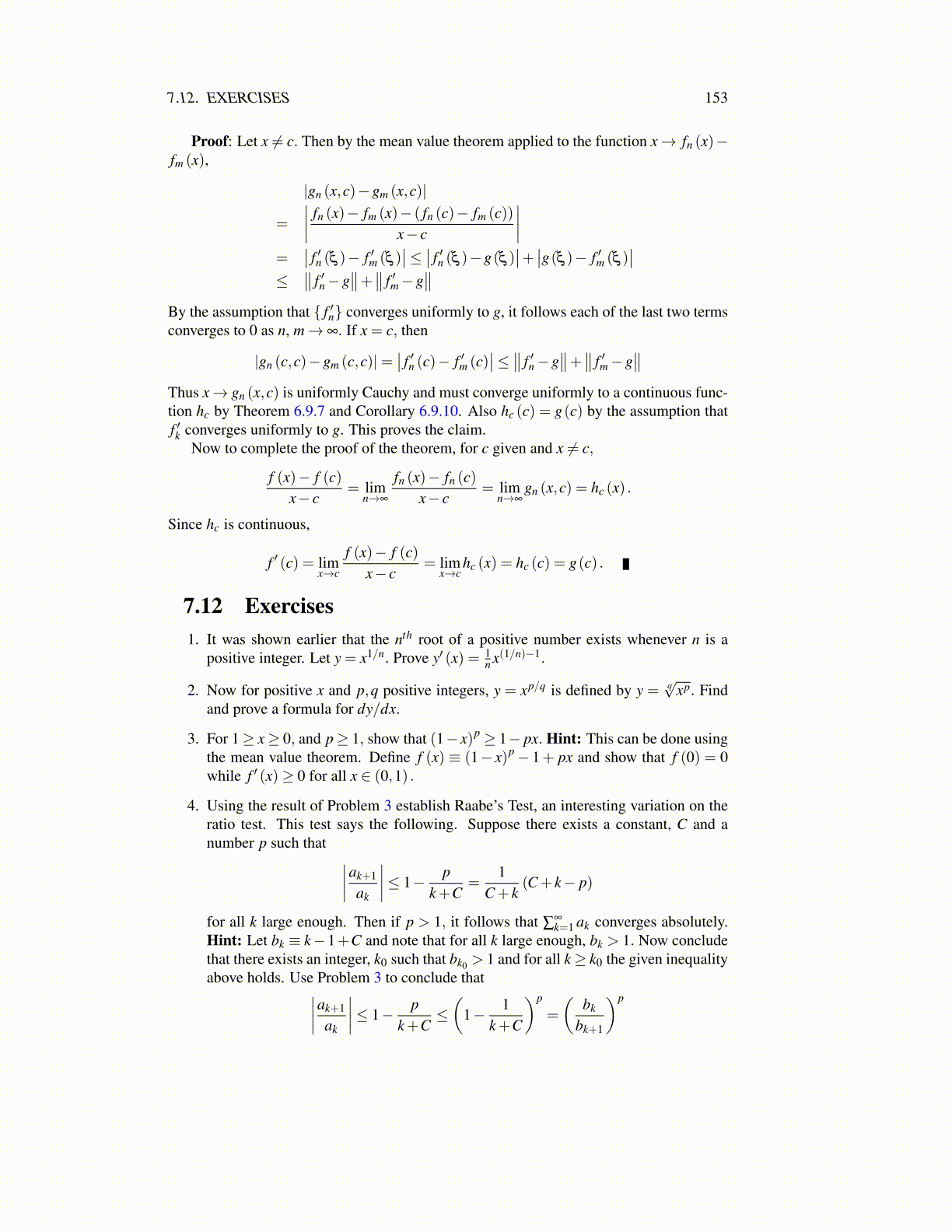
7.12. EXERCISES 153
11. In contrast to Problem 10, consider the sequence of functions
{ fn (x)}∞
n=1 =
{x
1+nx2
}∞
n=1.
Show it converges uniformly to f (x)≡ 0. However, f ′n (0) converges to 1, not f ′ (0).Hint: To show the first part, find the value of x which maximizes the function∣∣∣ x
1+nx2
∣∣∣ . You know how to do this. Then plug it in and you will have an estimatesufficient to verify uniform convergence.
12. This next sequence of problems will give an independent treatment of the Riemannintegral of piecewise continuous functions without the use of Riemann sums, beingbased instead on the mean value theorem and the Weierstrass theorem. For p(x)a polynomial on [a,b] , let P′ (x) = p(x) . Define
∫ ba p(x)dx ≡ P(b)−P(a). Show,
using the mean value theorem that this definition is well defined for polynomialsand satisfies
∫ ba (α p+βq)dx = α
∫ ba pdx+β
∫ ba qdx. Also show
∫ ba pdx+
∫ cb pdx =∫ c
a pdx.
13. For f continuous on [a,b] , using the Weierstrass theorem, let ∥pn− f∥ → 0 wherepn is a polynomial and ∥g∥ ≡ max{|g(x)| : x ∈ [a,b]} . Then define
∫ ba f (x)dx ≡
limn→∞
∫ ba pn (x)dx. Show this is well defined. Hint: If ∥pn∥ ,∥p̂n∥ → 0, then show
∥pn− p̂m∥ is small whenever n,m are large. Use the mean value theorem to verifythat
∣∣∣∫ ba (pn− p̂m)dx
∣∣∣ is small. Thus{∫ b
a pn
}is a Cauchy sequence and if another
{ p̂n} is chosen,{∫ b
a p̂n
}is a Cauchy sequence which converges to the same thing.
14. For f continuous, show that if F (x) ≡∫ x
a f dt, Then F ′ (x) = f (x) so any con-tinuous function has an antiderivative, and for any a ̸= b,
∫ ba f dx = G(b)−G(a)
whenever G′ = f on the open interval determined by a,b and G continuous on theclosed interval determined by a,b. Also verify that
∫ ba (α f +βg)dx = α
∫ ba f dx+
β∫ b
a gdx,∫ b
a f dx+∫ c
b f dx =∫ c
a f dx, and∫ b
a 1dx = b− a, and∫ b
a f dx = f (z)(b−a)for some z ∈ (a,b). Also explain the change of variables formula from calculus,∫ b
a f (g(x))g′ (x)dx = F (g(b))−F (g(a)) and integration by parts.
15. If f (x+)≡ limy→x+ f (y) and f (x−)≡ limy→x− f (y) both exist for all x ∈ [a,b] andif f is continuous on [αk−1,αk] where a = α0 < α1 < · · ·< αn = b, then define∫ b
af dx≡
n
∑k=1
∫αk
αk−1
f dx≡n
∑k=1
Gk ( f (αk−))−Gk ( f (αk−1+))
where G′k = f on (αk−1,αk) with Gk continuous on [αk−1,αk] . Show this coincideswith the above definition on each sub interval and is a well defined way to define theintegral of a function which is piecewise continuous, meaning: continuous on eachsub interval and possessing right and left limits at every point.
16. Generalize differentiability to the case where f has values in Fp. Simply replace |·|with ∥·∥ in the definition. Thus o(u) means lim∥u∥→0
o(u)∥u∥ = 0. Verify that if f (t) =
( f1 (t) , · · · , fp (t)) for t ∈ [a,b] , then f is differentiable (right or left differentiable atthe end points) if and only if this is true for each of the component functions and that